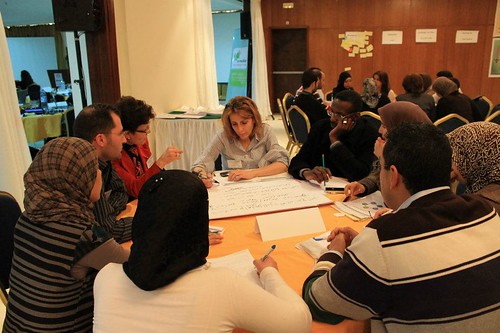
Note from Beth: Much of my work as Visiting Scholar at the Packard Foundation this year falls into areas: networked nonprofit practice and training design. As such, I’m facilitating many peer groups and always looking at how leverage peer learning. My colleagues at Monitor have taken a deep dive into the question of designing peer learning with impact. They want to hear about your experiences.
Unlocking the Potential of Peer Learning – Guest Post by Noah Flower
Many funders are interested in using peer learning to help nonprofit leaders advance their capabilities. The model has a natural appeal. Field-wide capacity is never going to be built one organization at a time. Plus, it makes intuitive sense for funders to take advantage of their visibility into many organizations and look for opportunities to bring leaders together around a common cause. It’s a form of network building.
Peer learning is certainly not new, and there is rich insight draw on from the study of communities of practice. Yet, we still have much to learn about how funders can tap the power of peer learning. When should you (and when shouldn’t you) consider starting a peer learning group? How do you set up a peer learning community that can prove valuable to a wide range of participants? What role(s) might a funder play in initiating and implementing a peer learning group? How can insight generated by the learning group be made more broadly available?
We at Monitor Institute have been digging into questions such as these as part of a broader reflection on the networks-focused work of the organizational effectiveness team at the David & Lucile Packard Foundation. They’re interested in strengthening their ability to use peer learning, and in the past three years have experimented with peer learning for building three types of capacity: network weaving, the strategic use/measurement of social media and investing in networks. Six initial observations have emerged as the most important:
- The substance of the peer learning experience should be of immediate use in the participants’ work—ideally an emerging area that needs attention where there is not yet a lot of information, and where the group can co-create material.
- The participants need a substantial amount of common ground in relation to the topic—whether it is their size, issue area, location, or other factors, they have to share enough that their commonalities are easily visible to one another.
- The group needs to quickly build trust, so that participants are comfortable learning alongside one another and seek out their peers for direct input. For many groups, meeting in-person is key, particularly in the early stages.
- The participants’ motivation is essential, so it works well for grantees to be given a free hand in choosing whether to join.
- It should be clear to all involved that the learning process will be exploratory and emergent rather than tightly structured and directive.
We and the Packard team are very interested in hearing the experiences of others. If you are a funder, when would you invest in peer learning? What role would you play in starting and running a peer learning group? What would you advise to make it successful?
Please let us know! We would love to hear from you. We will be sharing what we learn when the project concludes this spring.

Noah Flower works out of Monitor’s San Francisco office and has over six years of experience conducting research and analysis for clients across all three sectors, with an emphasis on using networked organizational structure to drive large-scale change. His work at Monitor Institute has addressed topics including social innovation, social media, and the changing context for philanthropy. Editing this blog, he produces content about the opportunities for using new technologies and networked strategies that emphasize openness, collaboration, and leverage to achieve greater social impact. As the team’s Director of Knowledge Management he helps the team capture new insight, hone its toolkit, and pioneer new approaches. This blog post was originally published on the Working Wikily blog

Leave a Reply